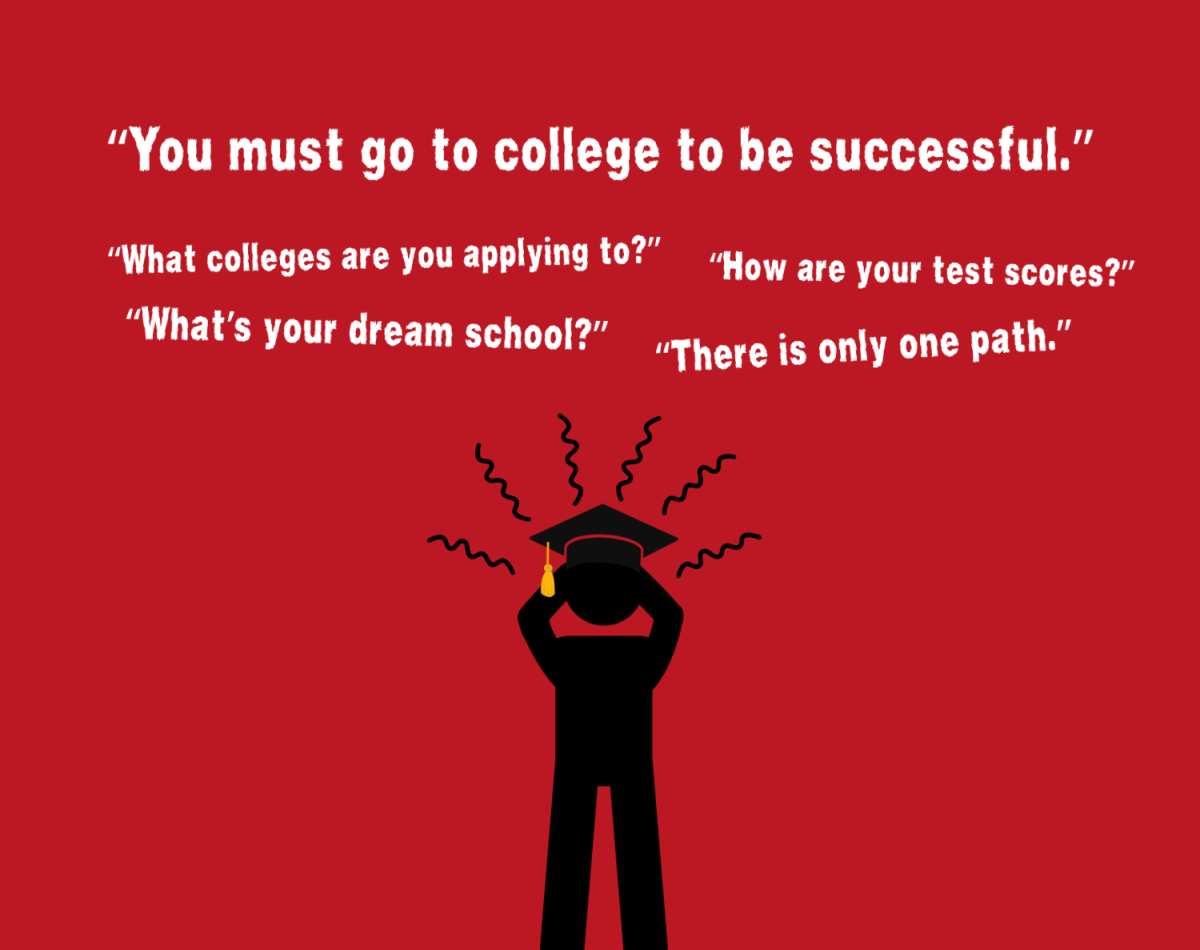
BY QUINN MULHOLLAND
Christian Coyotl did not have many advantages growing up. Originally from Mexico, the South Atlanta School of Law and Social Justice senior lives in the projects and says his parents aren’t at home most of the time. As a result, Coyotl didn’t do very well academically while he attended Crawford Long Middle School.
“I was really in the bottom of my classes there,” Coyotl said. “I really didn’t really care much about school when I got there. I just usually slept in class and really didn’t listen to anyone.”
Initially, because of his test scores, Coyotl was placed on the advanced track of students. Soon, however, teachers realized that he couldn’t do much of the work he was assigned, partially because English wasn’t his first language, and he was put back into the on-level track. Coyotl was glad to be moved back because he said he felt uncomfortable around the high-performing students.
“I really did not enjoy being around them because I couldn’t relate to none of them,” Coyotl said. “I couldn’t relate to anything they did because they had parents, they went out there, they went places, they could buy stuff, they watched shows, they had cable. I didn’t.”

The difference between Coyotl and his high-achieving peers could have pushed him away from the honors track, but in the end it instead made him return to rigorous classes. Coyotl’s love for community service and helping those around him led him to realize that if he succeeded in school, he would be able to give back to the community that gave him a chance. And so he returned to the advanced classes with a renewed purpose.
“Every time I go out of the class, I try to think about them [the children from his neighborhood], and try to think about what can I help them with, what can I do for them, what can I give back to the community,” Coyotl said, “because they gave me an education.”
Coyotl plans to be the first in his family to attend college and is applying to schools such as Princeton and Columbia. He dreams of one day becoming a financial advisor and philanthropist. Stories like Coyotl’s, however, are exceedingly rare, according to an extensive Southerner analysis of demographic, test, finance and other school data from the 2010-2011 school year, the most recent year for which data is provided by the Governor’s Office of Student Achievement.
The analysis, which examined data from 10 school districts and 61 high schools across metro Atlanta, paints a bleak picture of a city divided, with economically diverse, well-funded, high-performing schools concentrated on the north side, and low-performing, racially and economically homogenous schools mostly located on the south side.
Since the time of the country’s founding, the idea of equal opportunity for all, no matter one’s socioeconomic background, has been ingrained in America’s ideology. This idea is inherently tied to the national commitment to a public education system that gives all U.S. children access to economic opportunity later in life. This is the system that Horace Mann, considered by many to be the grandfather of the modern public education system, championed in the early 19th century.
Yet the “great equalizer” that Mann envisioned public education to be has not always served its function. The strong correlation between family wealth and student achievement has been documented since at least 1966, when James Coleman highlighted it in one of the most significant educational studies to date, commissioned by the Civil Rights Act of 1964.
The reasons behind this correlation are less clear. Some argue that the gap results from school funding disparities, while others say it is caused by differences in the opportunities and resources students are afforded at home. What almost everyone can agree on, however, is that a more equitable system is necessary in order for the country to stay internationally competitive and to fulfill the promise of the American dream. Fifty years removed from the iconic March on Washington, a growing number of people are becoming convinced that the march toward educational equity could be the civil rights issue of this generation.
Part I: The Problem
The Achievement Gap

Family wealth has always been positively correlated with student achievement. But according to many researchers, the achievement gap between rich and poor is growing wider.
A 2011 report by Sean Reardon of Stanford University found that the socioeconomic achievement gap grew by 40 percent since the 1960s and is now almost double the racial achievement gap. In other words, family income is now a better predictor of academic achievement than race is.
Alethea Raynor, a principal associate at Brown University’s Annenberg Institute for School Reform, agrees that poverty plays a large role in determining a student’s academic success.
“In many ways educational opportunity is a reflection of economic opportunity,” Raynor said.
A Southerner analysis of statewide test scores from 61 high schools in four districts (APS, DeKalb County, Fulton County and Decatur City) supports Raynor’s claim. The analysis revealed that “non-economically disadvantaged” students consistently outperformed their “economically disadvantaged” peers by a wide margin on the End-Of-Course Tests. Poorer students had a failure rate 80 percent higher on the Ninth-Grade Literature and Composition EOCT and 40 percent higher on the Math I EOCT.
Results from the National Assessment of Educational Progress, an exam that has been administered to U.S. students since 1969, and the Programme for International Student Assessment, a study comparing student performance in various subjects, also show a large difference in scores between rich and poor students.
In February 2013, a national group of education experts called the Equity and Excellence Commission issued a report to Secretary of Education Arne Duncan, in which the authors lamented the growing class divide in American education. “While some young Americans—most of them white and affluent—are getting a truly world-class education, those who attend schools in high poverty neighborhoods are getting an education that more closely approximates school in developing nations.”
From Day One

Richard Rubinson, an education expert at Emory University, said the primary reason for the socioeconomic achievement gap is a student’s relationship with his or her family.
“The more kids are enveloped in their family and the more their parents are involved in their school life, involved in their personal life, discipline them, oversee them, are involved in the school, all of those things, the better kids do, in terms of achievement,” Rubinson said. “By and large, those things happen more in higher socioeconomic status families.”
Reardon, the Stanford researcher, argued in an April article he wrote for The New York Times that the gap between rich and poor students starts long before they enter school, and grows only slightly from elementary to high school. Reardon attributed this early gap to two factors: rising income inequality and the increasing amounts of money being spent by affluent parents on their children.
Richard Kahlenberg, a senior fellow at The Century Foundation, agrees that poor parents haven’t been able to keep up with the amount of resources that wealthier parents can provide for their children.
“Wealthier parents are able to provide a variety of benefits that poor parents are not always able to, including good health care, proper nutrition and a safe place to study,” Kahlenberg wrote in an email to The Southerner.
In addition to spending more money on their children, affluent parents also are able to spend more time with them. According to a 2008 study by the National Bureau of Economic Research, mothers with a college degree spend an average of 4.5 hours more time each week with their children than mothers who didn’t graduate from college.
Raynor said low-income mothers often don’t spend time with their children because they can’t.
“[If] you are simply working a minimum-wage job, then you don’t have a lot of time, necessarily, to spend with your child, reading to your child, making sure the homework gets done,” Raynor said.
Raynor argued that the financial stress on low-income parents, who often have to take two jobs to support their families by themselves, takes away from time that could be spent with their children.
“Many young people I know here in Savannah, Chatham County, they literally pass their parents when they get home from school,” Raynor said. “Their parents are leaving for a night job.”
 The effects of this lost time together and of poverty are devastating and immediate. According to a New York Times piece by Laura D’Andrea Tyson of the University of California-Berkeley, early childhood poverty hurts brain development: “At the age of 3, children in poverty have smaller vocabularies than their peers and a harder time sorting and organizing information and planning ahead.”
The effects of this lost time together and of poverty are devastating and immediate. According to a New York Times piece by Laura D’Andrea Tyson of the University of California-Berkeley, early childhood poverty hurts brain development: “At the age of 3, children in poverty have smaller vocabularies than their peers and a harder time sorting and organizing information and planning ahead.”
Coyotl notices these disadvantages in the children who live in his neighborhood.
“Most of my friends, some little kids as well, during summer, most of them didn’t have parents who took them to day care or summer camps like most fortunate people do,” Coyotl said.
One of the things that motivated Coyotl to apply himself at school was watching what happened to his friends from middle school.
“Most of them are locked up in jail or dead,” Coyotl said.
Educational Opportunity
Many experts say that, although achievement gaps start long before children enroll in school, their experiences in the schools they attend widen the gap. Kahlenberg argues that the socioeconomic context of the school a student attends has a large impact on his or her academic achievement. He says that the role of schooling in widening the achievement gap was documented as early as the 1966 Coleman report.
“This study has been replicated time and again for almost 50 years,” Kahlenberg wrote. “High poverty schools have weaker teachers, on average, less parental support, as well as inadequate funding.”
The Southerner analysis of demographic data confirms that many low-income students attend economically homogenous schools. The average metro Atlanta low-income student (a student eligible for the National School Lunch Program) attends a school that is 69 percent low income, while the average high-income student attends a school that is 38 percent low-income.
 In addition to having more socioeconomic diversity, many schools in high-income neighborhoods also offer students more learning opportunities than those in poorer areas, according to Raynor.
In addition to having more socioeconomic diversity, many schools in high-income neighborhoods also offer students more learning opportunities than those in poorer areas, according to Raynor.
“In some schools, there are opportunities for AP classes, there are gifted and talented programs, there’s band, there’s a school newspaper, and then you look in other schools and they barely seem to have just basic instruction materials,” Raynor said.
A 2004 survey of 3,336 teachers across America by the Peter Harris Research Group revealed that teachers in high-poverty schools reported, among other things, “higher numbers of uncredentialed teachers,” “inadequate physical facilities,” “evidence of vermin (cockroaches, mice, and rats) in school buildings” and “inadequate textbooks and materials for students to use in class or to take home.”
Former Grady teacher Scott Stephens believes that educational resources should be prioritized for disadvantaged students.
“If we’re talking about leveling the playing field, we’re going to have to give some extra help to kids who are low academically, and one way to do that is reduce class size and get them better teachers,” Stephens said.

Teacher quality is another source of inequity cited by many education experts. Stephens said one reason for the difference in school quality between low- and high-income areas is that low-income schools have disproportionately high numbers of inexperienced teachers.
“Right now, what we do is put the least experienced teachers in the low-performing schools because there’s such a big teacher turnover there,” Stephens said, “and by the time you get experienced, you work your way up to a good school, like Grady or North Atlanta.”
Emory’s Rubinson doesn’t believe that teacher quality plays a major role in the socioeconomic achievement gap.
“Teachers really aren’t the issue,” Rubinson said. “I mean, it’s better to have good teachers, certainly, but that’s not what causes the achievement gap.”
In a November piece for The Atlanta Journal-Constitution, however, Duke University professor Helen Ladd wrote that “experienced teachers, on average, are more effective at raising student achievement.” Ladd argued that organizations like Teach For America, which places college graduates in disadvantaged schools, result in high teacher turnover at those schools because “more than half [of TFA recruits] leave after fulfilling their two-year commitment, and more than 80 percent do so after three years.”

The Southerner found that the average low-income student attends a school where teachers have an average of two years less experience than those at the average high-income student’s school.
Charlotte Davis, principal of the South Atlanta School of Law and Social Justice, which employs two TFA graduates, believes that TFA is “an excellent program.” She does, however, understand the concern that TFA graduates don’t stay long at the school to which they are assigned.
“I’m looking for teachers with longevity,” Davis said. “I don’t want for an individual to use this as a stepping stone to something else because this is my passion.”
Funding
One of the reasons for high teacher turnover rates in high-poverty schools, according to the 2004 survey of teachers, is that high-poverty schools tend to have lower-quality facilities. Many experts said that the reason for this inequity is that high-poverty schools often receive less funding than those in wealthier areas.
The reasons behind this funding disparity are complex. A recent article in The New York Times cited research that showed that “the United States is one of few advanced nations where schools serving better-off children usually have more educational resources than those serving poor students.”

According to the article, decentralization of funding was a key reason for this inequity. In the United States, the federal government provides only 14 percent of school funding, compared with an average of 54 percent among industrial nations. As a result of this decentralization, school districts have to look more to state and local sources for funds.
The Equity and Excellence Commission wrote in its aforementioned report that the problem with a system of locally funded schools is that “people living in property-rich districts can fund their public schools more generously, and at lower tax rates, than can residents in lower-income areas.” And according to the Educational Law Center, only 17 states provide more funding to high-poverty districts than to low-poverty districts.
Rubinson, however, isn’t convinced that increased funding for low-income schools can narrow the socioeconomic achievement gap.
“Spending per pupil in the U.S. has gone up like 500 percent in the last 20 years, yet the achievement gap has gotten wider,” he said.
Rubinson insists that “it’s not the buildings, it’s not the schools; it’s what happens in the school.”
What happens in schools, however, can be affected by how much funding they receive. And in Georgia, according to an Atlanta Journal-Constitution column by Joe Martin, the head of the Georgia School Funding Association, “state allotments to local systems have decreased by 24.8 percent on a per-student, inflation-adjusted basis over the last decade,” which means a more than $30,000 decrease for the typical class. On top of that, Martin wrote, the state has further cut assistance to the least wealthy districts.
The cut in state subsidies means that school districts are increasingly relying on local sources for funding. According to a Southerner analysis of school funding data, more than half of the average metro Atlanta district’s funds come from local tax revenue.
A Vicious Cycle
A growing body of research suggests America is not a land of opportunity, with income inequality increasing and social mobility plummeting, especially in Atlanta.

In a Dec. 4 speech at the Center for American Progress, President Obama said, “I believe this is the defining challenge of our time: Making sure our economy works for every working American.” Obama pointed out that a child born into the bottom fifth of the socioeconomic scale has less than a 5 percent chance at climbing to the top fifth.
Giving a better education to these children would not only help them, Raynor said. It would help the community at large.
“In some ways, we are all connected to this destiny,” she said. “This is not just the destiny of the kid on the other side of the tracks because the kid on the other side of the tracks either can or cannot contribute to the economic viability of this community, the stability of this community, the growth of this community.”
The American economy is becoming increasingly top-heavy, with a college education more and more necessary to access high-paying jobs. According to a 2012 Georgetown University study, since 2007, the number of jobs requiring postsecondary education has increased by more than 2 million, and the number of jobs for those with only a high school diploma fell by almost 6 million.
 According to a 2011 study by University of Michigan researchers, high-income students are completing college at much higher rates than in the 1980s, while the college completion rate for low-income students has barely increased over this period. Additionally, a 2012 Stanford study shows that students from families in the richest 20 percent are eight times more likely to enroll at a highly selective college than are students from the poorest 20 percent of families.
According to a 2011 study by University of Michigan researchers, high-income students are completing college at much higher rates than in the 1980s, while the college completion rate for low-income students has barely increased over this period. Additionally, a 2012 Stanford study shows that students from families in the richest 20 percent are eight times more likely to enroll at a highly selective college than are students from the poorest 20 percent of families.
This disparity exists because many low-income students, even if they are high achievers, don’t apply to selective colleges, according to research from the Brookings Institute.
South Atlanta’s Coyotl is the exception. His experience, however, shows that low-income students can apply to top colleges, given the proper motivation.
“I dream so big sometimes that it really gets to my head,” Coyotl said. “I cannot stop and dream small, which [is] really reflected in the schools that I chose, like Princeton, and the University of Rochester and Columbia University.”
Coyotl said at first, the college application process was hard, because no one in his family had done it before, but then he realized that he had to “stop thinking that way and try to see that I really have to go through with this and finish this if I really want to be this person.”
[slideshow_deploy id=’9279′]
Part II: The Solution
Testing vs. Teachers
Recent educational initiatives aimed at narrowing the achievement gap, including President Bush’s “No Child Left Behind” and President Obama’s “Race To The Top,” have emphasized the use of testing in evaluating both student progress and teacher performance. Lisa Guisbond, an assessment reform analyst at the National Center for Fair & Open Testing, or FairTest, opposes this increased use of standardized tests, arguing that it hurts low-income schools the most.
“Poor communities … are the places where you tend to see more narrowing of the curriculum to the tests in subjects, teaching to the tests, perhaps pushing students out, creating a sort of more high pressure, less engaging academic environment,” Guisbond said.
This less engaging environment leads to something Guisbond calls the “school-to-prison pipeline” because students who are less engaged will more likely act up.
“There’s a way in which high-stakes standardized testing works hand-in-glove with zero tolerance discipline policies that widen the school-to-prison pipeline and get more kids caught up in the juvenile justice system,” Guisbond said.
In a 2011 New York Times piece, however, columnist David Brooks wrote that standardized tests don’t always result in a narrowing of the curriculum, arguing that many low-income schools that emphasize testing are “the places where students are most likely to participate in chess and dance. They are the places where they are most likely to read Shakespeare and argue about philosophy and physics.”
South Atlanta’s Principal Davis, whose school is 95 percent low-income, also doesn’t see a problem with emphasizing standardized testing.
“The only way that you can ascertain where an individual is is to assess them,” Davis said.
Guisbond, however, argued that standardized tests allow schools to focus only on a select few students, to the detriment of the majority.
“Administrators have said, literally, ‘Don’t worry about the kids that are way behind. Don’t worry about the kids that are ahead of the class, just focus on the kids that are just about to get over the bar, and then we’ll get the biggest bang for our buck, the biggest payoff,’” Guisbond said, “and then they’re literally just ignoring whole segments of the student population in order to get the test score bottom line where they need to be.”
Guisbond likens standardized tests to looking at the dashboard of a car, and actually talking to and observing students to the windows and mirrors.
“Imagine what would happen if you did not look out the windows or in the mirrors and only looked at your speedometer or your temperature gauge,” Guisbond said. “You’d crash in a moment.”
Brooks argued in a 2009 piece that Obama’s plan would be effective because it would “increase merit pay for good teachers (the ones who develop emotional bonds with students) and dismiss bad teachers (the ones who treat students like cattle to be processed).”

Guisbond disagrees, saying that Race To The Top encouraged the evaluation of teachers based on students’ test scores, which, she argued, discourages teachers from working with the most disadvantaged students.
“If you really want to provide the most needy kids with the best, most experienced teachers, then you don’t want to have a system that’s going to be likely to punish them for working in that environment,” Guisbond said.
Guisbond points to Finland as an example of a country that has performed well on international exams but employs the opposite approach of U.S. education reformers. According to Guisbond, Finland also has very few standardized tests, and teachers are given a great deal of autonomy in the classroom, as opposed to America, where “we sort of base our system on not trusting that teachers know what they’re doing.”
Guisbond argued that teachers in America need to be held in higher regard, like they are in Finland, where teacher training programs are highly selective.
“I don’t want to have my children spending every day with someone who feels constantly under attack and derided and abused and not treated fairly,” Guisbond said.
The Equity and Excellence Commission argued in its report that to attract more top college graduates to the teaching profession, teacher pay should be raised, free high-quality teacher training programs should be offered, teachers should be given more professional development, resources, and support, and teachers should not be evaluated solely based on the performance of their students.
Preschool for All
Another educational initiative Obama has been pushing for in recent months is universal preschool for all children. During his February visit to a preschool in Decatur, Obama told a crowd, “I propose working with states like Georgia to make high-quality preschool available to every child in America.”

Kaitlin Pennington, an education policy analyst at the Center for American Progress, supports the president’s push for universal preschool.
“The younger you are whenever you’re getting the information that you need, the better,” Pennington said, “and so universal pre-K can definitely help with that.”
Research from University of Chicago professor James Heckman backs up Pennington’s claim, showing that “investment in early education for disadvantaged children from birth to age 5 helps reduce the achievement gap, reduce the need for special education, increase the likelihood of healthier lifestyles, lower the crime rate and reduce overall social costs.”
Stanford professor Larry Cuban, however, argues in an April piece for The Washington Post that universal preschool is no panacea because what constitutes a “high-quality” preschool varies widely in different circles.
Emory’s Rubinson also doesn’t believe universal preschool is the be-all and end-all for narrowing the socioeconomic achievement gap.
“If you send kids to preschool … they are certainly going to do better than kids who don’t go to preschool,” Rubinson said, “but that doesn’t mean they’re going to do better than the kids who are already in preschool. The middle-class has been sending their kids to preschool forever.”
Rubinson compared universal pre-K to watching a parade.
“At some point, you know, some jerk in front of you stands up to see better, and then once that guy stands up to see better, the person next to him has to stand up and see better,” Rubinson said. “Pretty soon everybody is standing up, but now, nobody’s seeing any better.”
Economic Integration
Kahlenberg, who has been described as “the intellectual father of the economic integration movement,” stressed the importance of economic integration in schools as a way to raise low-income students’ scores.
“Low income students who attend more affluent schools are two years ahead of low-income students stuck in high poverty schools on the fourth-grade National Assessment of Educational Progress in mathematics,” Kahlenberg wrote.

Kahlenberg argued that while attending a high-poverty school may have a negative impact on a middle-class student’s achievement, attending a mixed-income school has no negative impact, and the higher socioeconomic context that results benefits low-income students at the school. In a review of the book “The Diverse Schools Dilemma” by Michael Petrilli of the Thomas B. Fordham Institute, Kahlenberg explained why attending an economically mixed school helps low-income students but doesn’t hurt wealthier students.
“First, because schools like Piney Branch are still majority middle class and the numerical majority sets the tone in a school,” Kahlenberg wrote. “Second, because low-income and minority students have been found by a long line of researchers … to be more sensitive to changes in school quality given the weaker family environments on average found in low-income households. And, finally, most schools employ ability grouping in at least some subjects, such as math, which enables all students to move at their own pace.”
Rubinson, however, argues that the benefit of socioeconomic context that Kahlenberg describes is overstated.
“We’ve had a lot of history about that; that’s what integration through busing was about,” Rubinson said. “And that uniformly didn’t improve achievement for low-income students who were bused to high-income schools.”
Rubinson gave two reasons for this. First, he argued, moving low-income students to high-income schools lowers the average socioeconomic level of the school.
“If you take a bunch of low-SES [socioeconomic status] kids and put them in a high-SES context, you’ve diluted the high-SES context,” Rubinson explained. “You’ve destroyed the very context you’re trying to take advantage of.”
Second, Rubinson cited something called the “frog pond effect.”
“It’s better to be a big fish in a small pond,” Rubinson said. “You take a low-SES kid who is doing well in their low-SES school, and you plop him into the high-SES school, and what do you think happens to his or her relative standing now? It goes down. All of a sudden they’re a small fish in a big pond, and that has an additional negative effect on their achievement.”
Equity over equality
Raynor stresses that there is a difference between “equity” and “equality.”
“Equity means in my view, that everyone gets what they need, and that may not always be the same thing,” Raynor said.
According to this concept, the most disadvantaged students should get more resources than the least disadvantaged, according to Raynor. Stephens echoed this sentiment, arguing that teachers should be given incentive pay to work in high-poverty areas that need high-quality teachers the most.
“Right now, there’s no incentive for a teacher to be in that kind of school, except maybe an idealistic notion about equality or improving the lot of society in general,” Stephens said.
Raynor also discussed another way of creating a more equitable system: changing school funding formulas.
“I think one of the big [issues] that can be addressed, certainly at the local level, is the issue of funding,” she said.

In an article for EdWeek, Cynthia Brown, vice president for education policy at the Center for American Progress, argued that federal Title I formulas should be changed to allow fewer loopholes that result in low-poverty districts getting disproportionate amounts of funding. Brown also advocated for a new system of funding, “one in which states provide all nonfederal resources for education, and districts no longer have the power to raise funds from local property taxes.”
Principal Davis doesn’t worry about increasing the amount of funds she has to work with at South Atlanta. She focuses on how to use the funding that she does receive to best help students like Coyotl.
“The unfortunate dynamic that we experience is that the mindset of our students in this community is that mediocre is OK,” Davis said, “and so part of our job here is to explain to them and to communicate to them in multiple ways that mediocrity is not acceptable.”
Coyotl finally understood that concept, after years of mediocrity in middle school, when he realized that he could make a difference in the lives of those around him. He described an eye-opening encounter with a homeless man.
“I was walking down the street, and there was this old guy asking me, ‘Where are you going?’” Coyotl said, “and I told him I was going to church, and he was like, ‘What? You’re going to church?’ … Everybody in there [Coyotl’s neighborhood] is homeless, and I thought about high school at that moment—I don’t know why—and I thought about ‘Can I do something to change this?’”
Coyotl’s story is an inspiring one, but there are tens of thousands of other low-income public school students in metro Atlanta. The question is how many of them will be able to follow in Coyotl’s footsteps and what educators and government leaders can do to make the path shorter and easier to navigate. ¶
—
Author’s remarks: Find out why Southerner reporter and associate managing editor Quinn Mulholland chose to write about this issue and what he learned in the process of reporting on it.
Multimedia: Check out the interactive graphics and video that go along with the story.













